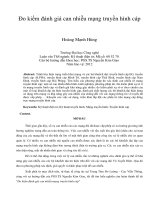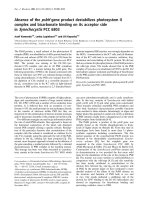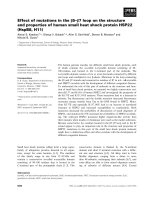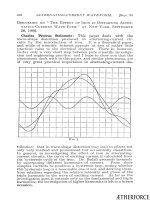Effect of ketoprofen co-administration and febrile state on pharmacokinetics of levofloxacin in goats following intravenous administration
Bạn đang xem bản rút gọn của tài liệu. Xem và tải ngay bản đầy đủ của tài liệu tại đây (331.42 KB, 7 trang )
Int.J.Curr.Microbiol.App.Sci (2018) 7(10): 2477-2483
International Journal of Current Microbiology and Applied Sciences
ISSN: 2319-7706 Volume 7 Number 10 (2018)
Journal homepage:
Original Research Article
/>
Effect of Ketoprofen Co-Administration and Febrile State on
Pharmacokinetics of Levofloxacin in Goats Following
Intravenous Administration
H. Patel Jatin1*, D. Vihol Priti2, A. Sadariya Kamlesh4, D. Patel Urvesh3,
D. Varia Rasesh1, K. Bhavsar Shailesh4 and M. Thaker Ashwin4
1
Department of Pharmacology and Toxicology, 2Department of Veterinary Pathology, College
of Veterinary Science and Animal Husbandry, Navsari Agricultural University,
Navsari 396450, India
3
Department of Pharmacology and Toxicology, College of Veterinary Science and Animal
Husbandry, Junagadh Agricultural University, Junagadh 362015, India
4
Department of Pharmacology and Toxicology, College of Veterinary Science and Animal
Husbandry, Anand Agricultural University, Anand 388 001, India
*Corresponding author
ABSTRACT
Keywords
Pharmacokinetic,
Levofloxacin,
Ketoprofen, Fever, Goat
Article Info
Accepted:
18 September 2018
Available Online:
10 October 2018
The pharmacokinetic of levofloxacin (4 mg/kg) was studied following intravenous
administration of levofloxacin in ketoprofen (3 mg/kg) treated and febrile
(Lipopolysaccharide induced) goats. The concentration of levofloxacin in plasma was
detected by using High Performance Liquid Chromatography. No significant changes were
reported in pharmacokinetic parameters following co-administration of levofloxacin with
ketoprofen. While under febrile state, significant increase in area under plasma curve and
decrease in total body clearance were observed. Integrating the pooled pharmacokinetic
data generated from the present study, levofloxacin via intravenous administration (4
mg/kg) repeated at 12 h interval is sufficient to maintain plasma concentration above the
0.05 g/mL MIC for most of the gram-positive and gram-negative microorganisms.
Introduction
Antibacterial and NSAIDs are used most
frequently in multiple drug prescriptions. It is
well
documented
that
concurrently
administered
drugs
may
alter
pharmacokinetics of one or both drugs.
Levofloxacin
is
a
third-generation
fluoroquinolone with a wide spectrum of
bactericidal activity. The drug is active against
Gram-negative, Gram-positive and anaerobic
bacteria including Pseudomonas species. It has
enhanced activity against Streptococcus
pneumoniae, Staphylococcus aureus and
Enterococcus species, besides having good
activity against Mycoplasma and Chlamydia
(Davis and Bryson, 1994; Martinez et al.,
2006). Ketoprofen is a routinely used as non-
2477
Int.J.Curr.Microbiol.App.Sci (2018) 7(10): 2477-2483
steroidal anti-inflammatory, analgesic and
antipyretic agent in veterinary practice
(Boothe,
1995).
Pharmacokinetics
of
levofloxacin, administered as single drug were
investigated in many species (Albarellos et al.,
2005; Dumka and Srivastava, 2007ab, Goudah,
2009; Varia et al., 2009; Goudah and
Hasabelnaby, 2010; Patel et al., 2012abc,
Goudah and Abo-El-Sooud, 2009; Patel et al.,
2013). However, there is no information
available on the influence of co-administration
of ketoprofen and febrile state on the
pharmacokinetic of levofloxacin in goats.
Looking to possibility for interaction of
ketoprofen and to reveal pharmacokinetic of
levofloxacin in goat under febrile state, the
study was undertaken to determine effect of
ketoprofen and febrile condition on
pharmacokinetics of levofloxacin in goat.
Materials and Methods
Experimental animals
The experiment was conducted on six healthy
adult (2-3 years of age) Surti goat, weighing
28-32 kg. Each animal was housed in a
separate pen and provided standard ration with
ad libitum water. Goats were kept under
constant observation for two weeks before the
commencement of the experiment and
subjected to clinical examination to exclude
the possibility of any diseases. The
experimental protocol was approved by
Institutional Animal Ethics Committee.
grade) were purchased from Merck Limited,
Mumbai.
Drug administration and sample collection
All six animals were randomly allocated to
receive injection of levofloxacin at the dose
rate of 4 mg/kg. A washout period of 2 weeks
was observed between treatments. The
intraveneous injection (4 mg/kg) was
administered in jugular vein, while ketoprofen
was administrated via. deep intramuscular (3
mg/kg) in gluteal muscle. Blood samples (3
mL) were collected, before administration and
at 5, 10, 15, 30 min and 1, 2, 4, 8, 12, 18, 24
and 36 h after concurrent intravenous and
intramuscular administration of levofloxacin
and ketoprofen respectively from contralateral
jugular vein. Febrile state in goat was induced
by injecting lipopolysaccharide (LPS) of
Escherichia coli (O55:B5) at the dose rate of
0.2 µg/kg body weight intravenously (Verma
and Roy, 2006). LPS was repeated at dose rate
of 0.1 and 0.05 µg/kg at 12 h and 24 h,
respectively to maintain the febrile state up to
36 h. Blood samples (3 mL) were collected,
before administration and at 5, 10, 15, 30 min
and 1, 2, 4, 8, 12, 18, 24 and 36 h after
intravenous administration of levofloxacin in
febrile goats. Goats were monitored for any
adverse reactions during the entire study
period. Blood samples were subjected to
centrifugation at 3000g for 10min and plasma
samples was collected and preserved -20 oC,
and analyzed within 48 h for determination of
levofloxacin concentration.
Drug and chemical
Levofloxacin infusion (500 mg/100 mL;
Tavanic, Aventis Pharmaceutical Ltd,
Bangalore) was procured from local
pharmacy. Levofloxacin technical grade
powder was procured from Moxi Laboratory
Pvt. Ltd., Gujarat, India. Acetonitrile,
Triethylamine, Perchloric acid (70%) and
Ortho-phosphoric acid (min. 58%) (Analytical
Analytical assay of levofloxacin
pharmacokinetic analysis
and
Levofloxacin concentration in plasma samples
was determined by reverse-phase High
Performance Liquid Chromatography (HPLC)
after extraction, using a reported assay (Varia
et al., 2009) with minor modifications. The
High Performance Liquid Chromatography
2478
Int.J.Curr.Microbiol.App.Sci (2018) 7(10): 2477-2483
(HPLC) apparatus (Laballiance, USA)
comprised of quaternary gradient delivery
pump (model AIS 2000), UV detector (model
500) and C18 column (Thermo ODS: 250 x
4.6 mm ID) were used. Pharmacokinetic data
integration was done by software “Clarity”
(Version 2.4.0.190). Pharmacokinetic data of
levofloxacin following intravenous injection
in ketoprofen treated and in febrile goats were
compared to intravenous injection of
levofloxacin alone in goats (Patel et al., 2013)
Solution of pure enrofloxacin powder (40 l
of 0.5 mg/mL concentration) was utilized as
an internal standard (IS). After adding internal
standard in each plasma samples (500 µL), it
was deproteinized by addition of perchloric
acid (50 l) and vortexed for one minute. This
was followed by centrifugation at 3000 g for
10 minutes. An aliquot of supernatant was
collected in clean vial and 20 µL was injected
into loop of HPLC system using 25 L glass
syringe (Hamilton Bonaduz AG, Switzerland).
The mobile phase consisted of a mixture of
1% triethylamine in water and acetonitrile
(85:15 v/v) adjusted to pH 3.0 with orthophosphoric acid. Mobile phase was filtered by
0.45 size filter (Ultipor N66Nylone 6,6
membrane, PALL Pharmalab filtration Pvt.,
Ltd., Mumbai) and degassed by ultrasonication. Thereafter mobile phase was
pumped into column at a flow rate of 1.5
mL/min at ambient temperature. The effluent
was monitored at 290 nm wavelength.
Calibration curve was prepared daily for drug
concentration ranging from 0.01 to 50 µg/mL.
The assay was sensitive (LLOD: 0.01 µg/mL),
reproducible and linearity was observed from
0.01 to 50 µg/mL (r2 = 0.99). The lower limit
of quantification of the drug with a coefficient
of variation was less than 8.36% for 0.01
g/mL concentration. The mean extraction
recovery from plasma was >82.81 ± 3.83% at
the spiked concentrations between 0.01 and 50
g/mL. Precision and accuracy were
determined using quality control (QC)
samples at concentrations 0.05, 1, 2.5, 10 and
50 µg/mL (5 replicates each per day). The
intraday and interday coefficients of variation
for 5 QC samples were satisfactory with the
relative deviations (RSD) of less than 9.77 %.
PK/PD integration
The peak plasma drug concentration (Cmax)
and area under the curve (AUC(0-)) were
applied in the calculation of the predictors of
efficacy (Cmax/MIC and AUC(0-)/MIC) for
levofloxacin
following
intravenous
administration in ketoprofen treated and
febrile goat. MIC90 of 0.05 µg/mL of
levofloxacin has been taken into consideration
to determine dosage of levofloxacin.
Statistical analysis
Levofloxacin plasma concentration and
pharmacokinetic parameters of different
treatment groups were compared by students’
“t” test using SPSS software (version 12.0.1).
Results and Discussion
Plasma levofloxacin concentrations at
different time intervals following intravenous
injection under febrile state and ketoprofen coadministered intramuscularly in goats is
presented as semi logarithmic plot in Figure 1.
On concurrent administration of levofloxacin
(4 mg/kg, IV) and ketoprofen (3 mg/kg, IM),
the
initial
plasma
concentration
of
levofloxacin at 2 min was 11.1 ± 0.41 μg/mL,
which declined rapidly to 2.32 ± 0.08 μg/mL
at 1 h and the drug concentration of 0.015 ±
002 μg/mL was detected up to 18 h. Plasma
drug concentration of 11.22 ± 0.42 μg/mL
observed at 2 min in febrile goats declined to
2.60 ± 0.11 μg/mL at 1 h, which was
significantly higher as compared to plasma
drug concentration found at 1 h in normal
2479
Int.J.Curr.Microbiol.App.Sci (2018) 7(10): 2477-2483
goats. Plasma drug concentrations observed
were significantly higher from 1 to 18 h in
febrile goats than normal goats except at 4 h.
The drug (levofloxacin) levels above the
minimum inhibitory concentration (MIC: 0.05
g/mL) were detected in plasma up to 12 h
following co-administrated with ketoprofen
and in febrile state. Various levofloxacin
pharmacokinetic determinants that describe
the absorption and elimination pattern after
concurrent
levofloxacin
intravenous
administration with ketoprofen intramuscular
administration and under febrile state in goats
are presented in Table 1.
No adverse effects or toxic manifestations
were observed in goats following intravenous
administration levofloxacin (4 mg/kg) in
concurrent administration with ketoprofen (3
mg/kg, IM). In endotoxin induced febrile
state, symptoms viz., increased respiration and
pulse rate, decrease in feed intake, dryness of
mouth and muzzle, and incoordination in
movements were observed.
Following intravenous administration of
levofloxacin in ketoprofen-treated goats, no
significant changes in pharmacokinetic
parameters were observed compared to
pharmacokinetic parameters of levofloxacin in
normal goats (Patel et al., 2013). Following
intravenous administration of levofloxacin in
febrile goats, no significant changes were
observed with the mean values of important
pharmacokinetic parameters viz. Vdss, t½α,
t1/2β, and MRT compared to levofloxacin
administration in normal goats. The values of
AUC (13.48 ± 0.48 g.h/mL) and AUMC
(40.01 ± 2.66 g.h2/mL) were significantly
higher than the values obtained after
levofloxacin administration in normal goats
(Patel et al., 2013). The value of ClB (0.29 ±
0.009 L/h/kg) was significantly lower than the
values
obtained
after
levofloxacin
administration in normal goats (0.35 ± 0.022
L/h/kg) (Patel et al., 2013).
Following intravenous administration of
levofloxacin in febrile goats, the significant
decrease in the Clearance (ClB) and increase in
Area under plasma curve (AUC) may be due
to endotoxin induced toxic and adverse effects
on the kidneys, including direct vascular
damage to the endothelium and platelet
aggregation in renal glomerular capillaries. It
also produces some functional changes
including decrease in the renal blood flow and
glomerular filtration rate and changes in the
intra-renal hemodynamics (Jernigan et al.,
1988, Hasegawa et al., 1999). Endotoxin
could produce a metabolic acidosis, which
would cause a decrease in urinary pH in
febrile animals (Van Miert, 1990) and may
favour reabsorption of drug from renal
tubules. In addition decrease in systemic
vascular pressure, central venous pressure,
cardiac output (Salam Abdullah and Baggot,
1986), the peripheral blood flow (due
increases in body temperature and to counter
act loss of heat), gastrointestinal and hepatic
blood flow, which has been reported in
ruminants given E. coli endotoxin (Waxman et
al., 2003). It is probable that the decrease in
glomerular filtration rate induced by
endotoxin plays an important role in the
decrease of body clearance of drugs which are
widely eliminated by the renal route, including
levofloxacin. In addition to this the acute
phase response induced by febrile state
includes synthesis of acute phase hepatic
proteins, including 1-acid glycoprotein,
which binds some drugs and may produce a
decrease in their clearance as levofloxacin has
22 % degree of plasma protein binding
(Goudah and Abo-El-Sooud, 2010).
It is suggested that the critical breakpoints
determining the efficacy of fluoroquinolones
are Cmax/MIC90 ≥8–10, and AUC 0−24/MIC90
≥100 to avoid bacterial resistance emergence
(Dudley, 1991; Drusano et al., 1993; MadrasKelly et al., 1996; Walker, 2000; Toutain et
al., 2002).
2480
Int.J.Curr.Microbiol.App.Sci (2018) 7(10): 2477-2483
Fig.1 Semilogarithmic plot of plasma concentrations after intravenous administration of
levofloxacin (LFX) (4 mg/kg) in Ketoprofen (KTP)-treated (3 mg/kg) and febrile goats. Each
point represents mean of six animals
Table.1 Levofloxacin (4 mg/kg) pharmacokinetic parameters following intravenous
administration in ketoprofen treated (3 mg/kg) and febrile goats. (Mean ± SE, n=6)
Pharmacokinetic
Parameter
Unit
Levofloxacin
(IV)
Levofloxacin
(IV) and
Ketoprofen (IM)
Levofloxacin (IV)
and Febrile State
Cp0
A
B
α
β
t1/2α
t1/2β
AUC0-∞
AUMC
Vdss
ClB
MRT
μg/mL
μg/mL
μg/mL
h-1
h-1
H
H
μg.h/mL
μg.h2/mL
L/kg
L/h/kg
H
6.68 ± 0.51
4.75 ± 0.50
1.92 ± 0.29
1.27 ± 0.13
0.27 ± 0.005
0.57 ± 0.05
2.53 ± 0.05
11.65 ± 0.71
30.17 ± 3.99
0.86 ± 0.02
0.35 ± 0.022
2.53 ± 0.19
7.41 ± 0.61
5.54 ± 0.70
1.86 ± 0.13
1.29 ± 0.088
0.27 ± 0.004
0.54 ± 0.03
2.56 ± 0.04
11.66 ± 0.23
29.28 ± 1.77
0.85 ± 0.02
0.34 ± 0.006
2.5 ± 0.10
6.49 ± 0.63
3.37 ± 0.88
3.11 ± 0.37
1.31 ± 0.19
0.27 ± 0.003
0.67 ± 0.20
2.5 ± 0.02
13.48 ± 0.43*
40.01 ± 2.66*
0.85 ± 0.03
0.29 ± 0.009*
2.95 ± 0.13
*Significant at p<0.05 when compared with respective values of intravenous levofloxacin administered alone in
goats (Patel et al., 2013).
Ka: Absorption rate constant, Β: Zero-time intercept of elimination phase, t1/2ka: Absorption half-life, t1/2β:
Elimination half-life, Cmax: Maximum drug concentration, T max: Time of maximum observed concentration in
plasma, AUC0-α: Area under curve, AUMC: Area under first moment of curve, Vdss: Volume of distribution at
steady state, ClB: Total body clearance, MRT: Mean residence time,
2481
Int.J.Curr.Microbiol.App.Sci (2018) 7(10): 2477-2483
Calculation of surrogate parameter following
intravenous administration of levofloxacin (4
mg/kg body weight) in ketoprofen-treated and
febrile goats resulted in Cp0/MIC ratio (MIC:
0.05 g/ml) of 148.20 and 129.80
respectively, which exceeds the recommended
ratio of Cp0/MIC ratio.
For AUC/MIC ratio at MIC: 0.05 g/mL and
0.1 g/mL were found higher than 100 in
ketoprofen-treated (233.20 and 116.60) and
febrile condition (269.60 and 134.80)
respectively.
Following
intravenous
administration, average minimum inhibitory
concentration i.e 0.05 μg/ml of levofloxacin
maintained in plasma up to 12 h in ketoprofen
treated goats and in febrile goats. Considering
the values of Cmax/MIC and AUC/MIC ratios
obtained in the present study, it can be
concluded that levofloxacin administered
intravenous at the dose rate of 4 mg/kg at 12
hr interval may be efficacious against bacteria
with MIC values under 0.05 g/mL
satisfactorily.
Levofloxacin
can
successfully
coadministrated with Ketoprofen for combating
inflammatory conditions and in febrile
condition without alteration of dosage
regimen of levofloxacin.
Moreover
integrating
the
pooled
pharmacokinetic data generated from the
present study, levofloxacin via intravenous
administration (4 mg/kg) repeated at 12 h
interval is sufficient to maintain plasma
concentration above the 0.05 g/mL MIC for
most of the gram-positive and gram-negative
microorganisms.
Acknowledgement
The authors express thanks to College of
Veterinary Science and Animal Husbandry,
AAU, Anand for providing necessary
facilities and funding.
References
Albarellos, G.A., Ambros, L.A. and Landoni,
M.F.
2005.
Pharmacokinetics
of
levofloxacin after single intravenous and
repeat oral administration to cats. J. Vet.
Pharmacol. Ther., 28: 363-369.
Boothe, D.M., 1995. The analgesic, antipyretic,
anti-inflammatory drugs. In: Veterinary
Pharmacology and Therapeutics 8th (Ed.),
Iowa State University Press, Ames, pp.
444-445.
Davis, R. and Bryson, H.M. 1994. Levofloxacin:
A review of its antibacterial activity,
pharmacokinetics and therapeutic efficacy.
Drugs, 47: 677-700.
Drusano, G.L.; Johnson, D.E.; Rossen, M. and
Standiford, S. C. 1993. Pharmacodynamis
of a fluroquinolone antimicrobial agent in
a neutropenic rat model of Pseudomonas
sepsis. Antimicrob. Agents Chemother.
37:483-490.
Dudley, M.N. 1991. Pharmacodynamics and
pharmacokinetics of antibiotics with
special reference to fluroquinolones. Am.
J. Med. 91: 45-50.
Dumka, V.K. and Srivastava, A.K. 2007a.
Kinetic disposition, urinary excretion and
dosage regimen of subcutaneously
administered levofloxacin in cross bred
calves. Iran. J. Vet. Res., 8: 313-318.
Dumka, V.K. and Srivastava, A.K. 2007b.
Disposition kinetics, urinary excretion and
dosage
regimen
of
levofloxacin
formulation following single intravenous
administration in crossbred calves. Vet.
Res. Commun., 31: 873-879.
Goudah, A. 2009. Pharmacokinetics of
levofloxacin in male camels (Camelus
dromedarius). J. Vet. Pharmacol. Therap.,
2: 296-299.
Goudah, A. and Abo-El-Sooud, K. 2009.
Pharmacokinetics, urinary excretion and
milk penetration of levofloxacin in
lactating goats. J. Vet. Pharmacol. Ther.,
32: 101-104.
Goudah, A. and Hasabelnaby, S. 2010.
Disposition kinetics of levofloxacin in
2482
Int.J.Curr.Microbiol.App.Sci (2018) 7(10): 2477-2483
sheep after intravenous and intramuscular
administration. Vet. Med. Int., 2010: 1-6.
Hasegawa, T., Takagi, K., Kitaichi, K. 1999.
Effects of bacterial endotoxin on drugs
pharmacokinetics. Nagoya J Med. Sci. 62,
11–28.
Jernigan, A.D., Hatch, R.C., Wilson, R.C.,
Brown, J., Crowell, W.A., 1988.
Pathologic changes and tissue gentamicin
concentrations
after
intravenous
gentamicin administration in clinically
normal and endotoxemic cats. Am. J. Vet.
Res. 49, 613–617.
Madras-Kelly,
K.J.;
Ostergaard,
B.E.;
BakerHovde, L. and Rotschafer, J.C. 1996.
Twenty four-hour area under the
concentration time curve/MIC ratio as a
generic predictor of fluoroquinolone
antimicrobial effect by using three strains
of Pseudomonas aeruginosa and an in vitro
pharmacodynamics model. Antimicrob.
Agents Chemother. 40: 627-632.
Martinez, M., McDermott, P and Walker, R.
2006.
Pharmacology
of
the
fluoroquinolones: A perspective for the use
in domestic animals. Vet. J., 172: 10-28.
Patel J. H., Vihol P. D., Patel U. D., Bhavsar S.
K. and Thaker A. M. 2013.
Pharmacokinetics
of
levofloxacin
following subcutaneous administration in
goat. J Vet. Pharmacol Toxicol. 12(1-2):
35-38.
Patel, J.H., Varia, R.D., Vihol, P.D., Ratndeep,
S., Patel, U.D., Bhavsar, S.K., and Thaker,
A.M. 2012a. Pharmacokinetics and
Bioavailability of Levofloxacin in White
Leg Horn Birds. Indian Vet. J., 89(8): 6971.
Patel, U.D., Patel, J.H., Bhavsar, S.K. and
Thaker, A.M. 2012b. Pharmacokinetics of
levofloxacin following intravenous and
subcutaneous administration in sheep.
Asian J. Anim. Vet. Adv., 7:85-93.
Patel, U.D., Patel, J.H., Varia, R.D., Patel, H.B,
Bhavsar, S.K., and Thaker, A.M. 2012c.
Disposition kinetic of levofloxacin in
experimentally induced febrile model of
sheep. J. Pharmacol Toxicol., 7: 11-19.
Salam Abdullah, A. and Baggot, J.D. 1986.
Influence of induced disease states on the
disposition kinetics of imidocarb in goats.
J Vet. Pharmacol Ther. 9:192-197.
Toutain, P.L.; DelCastillo, J.R.E. and Bousquet
M´ elou A. 2002. The pharmacokinetic
pharmacodynamic approach to a rational
dosage regimen for antibiotics. Res. Vet.
Sci. 73(2):105-114.
Vann Miert, A. 1990. Influence of febrile disease
on the pharmacokinetics of veterinary
drugs. Ann. Recher. Vet. 21:11–28.
Varia, R.D., Patel, J.H., Patel, U.D., Bhavsar,
S.K. and Thaker, A.M. 2009. Disposition
of
levofloxacin
following
oral
administration in broiler chickens. Israel J.
Vet. Med., 64: 118-121.
Verma, D.K., Roy, B.K., 2006. Milk kinetics of
gatifloxacin after single dose intravenous
administration in healthy and febrile goats.
Indian J. Pharmacol., 38, 366-367.
Walker, R.D. 2000. The use of fluoroquinolones
for companion animal antimicrobial
therapy. Aust. Vet. J. 78(2): 84-90.
Waxman, S.; SanAndres, M.D.; Gonzalez, F.;
DeLucas, J.J.; SanAndres, M.I. and
Rodrıguez, C. 2003. Influence of
Escherichia coli endotoxin-induced fever
on the pharmacokinetic behavior of
marbofloxacin
after
intravenous
administration in goats. J. Vet. Pharmacol.
Ther. 26:65-69.
How to cite this article:
Patel Jatin, H., D. Vihol Priti, A. Sadariya Kamlesh, D. Patel Urvesh, D. Varia Rasesh, K. Bhavsar
Shailesh and Thaker Ashwin, M. 2018. Effect of Ketoprofen Co-Administration and Febrile State on
Pharmacokinetics of Levofloxacin in Goats Following Intravenous Administration.
Int.J.Curr.Microbiol.App.Sci. 7(10): 2477-2483.
doi: />
2483









